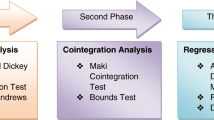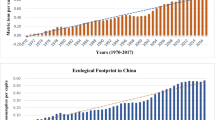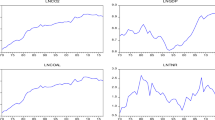Abstract
The interconnection between environmental protection and sustainable development is at the heart of discussion among all the intergovernmental agencies around the globe. Such discussion is considered highly important considering the role of finance, an abundance of fossil fuel and industrial value-added on economic activities and environmental issues. Meanwhile, few empirical studies in this line of discussions have documented policy options for projecting the path towards sustainable development in Argentina from 1971 to 2018. To contribute to the extant literature in filling this gap, this study examines whether finance can escalate a long-lasting economic shift that will change the path of carbon emission in Argentina using the novel econometric technique, dynamic Autoregressive Distributed Lag simulations. The modelling protocol incorporates the impact of the following economic agents such as population, economic growth, trade openness, and government consumption expenditure. Our result suggests that all the variables are cointegrated under the ARDL-bounds testing framework. The long and short-term estimates from the dynamic ARDL simulation show that finance and industrial value added interestingly offer policy options for CO2 mitigation in Argentina. Fossil fuel, population, economic growth, and government consumption expenditure have increasing an impact on CO2 emissions, exacerbating sustainability challenges in Argentina. In sum, improved finance and industrial restructuring are needed economic acumen that can accelerate a quick transition to a low-carbon development in Argentina, while fossil fuel, population, economic growth, and government consumption expenditure generate environmental challenges. Policy options in consideration of investors’ safety in carbonated companies in Argentina, these companies owe shareholders an obligation to invest in a resilient carbon capture and storage technology in a bid to decrease environmental degradation and align with environmental goals set by the Argentine government.





Similar content being viewed by others
Data availability
Note applicable
References
AhAtil A, Bouheni FB, Lahiani A, Shahbaz M (2019) Factors influencing CO2 emission in China: a nonlinear autoregressive distributed lags investigation
Ahmad M, Khan Z, Ur Rahman Z, Khan S (2018) Does financial development asymmetrically affect CO2 emissions in China? An application of the nonlinear autoregressive distributed lag (NARDL) model. Carbon Management 9(6):631–644
Ali HS, Law SH, Lin WL, Yusop Z, Chin L, Bare UAA (2019) Financial development and carbon dioxide emissions in Nigeria: evidence from the ARDL bounds approach. Geo Journal 84(3):641–655
Alston, L. J., & Gallo, A. (2000). Evolution and revolution in the Argentine banking system under convertibility: the roles of crises and path dependence (No. w8008). National Bureau of Economic Research.
Amin A, Dogan E, Khan Z (2020) The impacts of different proxies for financialization on carbon emissions in top-ten emitter countries. Sci Total Environ 740:140127–140127
Anser MK, Hanif I, Alharthi M, Chaudhry IS (2020) Impact of fossil fuels, renewable energy consumption and industrial growth on carbon emissions in Latin American and Caribbean economies. Atmosfera. 33(3):201–213
Anwar A, Siddique M, Dogan E, Sharif A (2020) The moderating role of renewable and non-renewable energy in environment-income nexus for ASEAN countries: Evidence from Method of Moments Quantile Regression. Renew Energy 164:956–967
Asane-Otoo E (2015) Carbon footprint and emission determinants in Africa. Energy 82:426–435
Asongu SA, Odhiambo NM (2020) The green economy and inequality in Sub-Saharan Africa: Avoidable thresholds and thresholds for complementary policies. Energy Explor Exploit 0144598720984226
Asumadu-Sarkodie S, Owusu PA (2016a) Energy use, carbon dioxide emissions, GDP, industrialization, financial development, and population, a causal nexus in Sri Lanka: With a subsequent prediction of energy use using neural network. Energy Sources, Part B: Economics, Planning, and Policy 11(9):889–899
Asumadu-Sarkodie S, Owusu PA (2016b) Carbon dioxide emissions, GDP, energy use, and population growth: a multivariate and causality analysis for Ghana, 1971–2013. Environ Sci Pollut Res 23(13):13508–13520
Azevedo ARG, Marvila TM, Fernandes WJ, Alexandre J, Xavier GC, Zanelato EB et al (2019) Assessing the potential of sludge generated by the pulp and paper industry in assembling locking blocks. Journal of Building Engineering 23:334–340
Beck, T., Demirgüç-Kunt, A., & Levine, R. (1999). A new database on financial development and structure. The World Bank.
Bekhet HA, Othman NS (2017) Impact of urbanization growth on Malaysia CO2 emissions: Evidence from the dynamic relationship. J Clean Prod 154:374–388
Belaïd F, Zrelli MH (2019) Renewable and non-renewable electricity consumption, environmental degradation and economic development: Evidence from Mediterranean countries. Energy Policy 133:110929
Brouwers R, Schoubben F, Van Hulle C (2018) The influence of carbon cost pass through on the link between carbon emission and corporate financial performance in the context of the European Union Emission Trading Scheme. Bus Strateg Environ 27(8):1422–1436
Cetin M, Ecevit E, Yucel AG (2018) The impact of economic growth, energy consumption, trade openness, and financial development on carbon emissions: empirical evidence from Turkey. Environ Sci Pollut Res 25(36):36589–36603
Chang CP, Dong M, Sui B, Chu Y (2019) Driving forces of global carbon emissions: from time-and spatial-dynamic perspectives. Econ Model 77:70–80
Chen S, Saud S, Bano S, Haseeb A (2019a) The nexus between financial development, globalization, and environmental degradation: Fresh evidence from Central and Eastern European Countries. Environ Sci Pollut Res 26(24):24733–24747
Chen X, Chen YE, Chang CP (2019b) The effects of environmental regulation and industrial structure on carbon dioxide emission: a non-linear investigation. Environ Sci Pollut Res 26(29):30252–30267
Dar JA, Asif M (2017) Is financial development good for carbon mitigation in India? A regime shift-based cointegration analysis. Carbon Management 8(5-6):435–443
Destek, M. A. (2019). Financial Development and Environmental Degradation in Emerging Economies. In Energy and Environmental Strategies in the Era of Globalization (pp. 115-132). Springer, Cham,
Dietz T, Rosa EA (1997) Effects of population and affluence on CO2 emissions. Proc Natl Acad Sci 94(1):175–179
Du YW, Huang TZ, Song SB, Li CH (2016) Study on the effects of the industrial structure evolution on carbon emissions—a case study. Chem Eng Trans 51:1177–1182
Ehrlich PR, Holdren JP (1971) Impact of population growth. Sci 171(3977):1212–1217
Ertugrul HM, Cetin M, Seker F, Dogan E (2015) The impact of trade openness on global carbon dioxide emissions: Evidence from the top ten emitters among developing countries. MPRA Paper No. 97539. Available at: https://mpra.ub.uni-muenchen.de/97539/
Friedrichs J, Inderwildi OR (2013) The carbon curse: Are fuel rich countries doomed to high CO2 intensities? Energy Policy. Vol. 62:1356–1365
Gokmenoglu KK, Sadeghieh M (2019) Financial development, CO2 emissions, fossil fuel consumption and economic growth: The case of Turkey. Strategic Planning for Energy and the Environment 38(4):7–28
Gozgor G (2017) Does trade matter for carbon emissions in OECD countries? Evidence from a new trade openness measure. Environ Sci Pollut Res 24(36):27813–27821
Hafeez M, Chunhui Y, Strohmaier D, Ahmed M, Jie L (2018) Does finance affect environmental degradation: evidence from One Belt and One Road Initiative region? Environ Sci Pollut Res 25(10):9579–9592
Hafeez M, Yuan C, Yuan Q, Zhuo Z, Stromaier D (2019) A global prospective of environmental degradations: economy and finance. Environ Sci Pollut Res 26(25):25898–25915
Huang L, Zhao X (2018) Impact of financial development on trade-embodied carbon dioxide emissions: Evidence from 30 provinces in China. J Clean Prod 198:721–736
International Monetary Fund. Monetary, Capital Markets Department, & Internationaler Währungsfonds. (2016). Republic of Moldova: Financial System Stability Assessment No. 16-70. International Monetary Fund
Javid M, Sharif F (2016) Environmental Kuznets curve and financial development in Pakistan. Renew Sust Energ Rev 54:406–414
Jebli MB, Farhani S, Guesmi K (2020) Renewable energy, CO2 emissions and value added: Empirical evidence from countries with different income levels. Struct Chang Econ Dyn 53:402–410
Jordan S, Philips AQ (2018) Cointegration testing and dynamic simulations of autoregressive distributed lag models.The. Stata J 18(4):902–923
Katircioğlu ST, Taşpinar N (2017) Testing the moderating role of financial development in an environmental Kuznets curve: empirical evidence from Turkey. Renew Sust Energ Rev 68:572–586
Kayani GM, Ashfaq S, Siddique A (2020) Assessment of financial development on environmental effect: implications for sustainable development. J Clean Prod 261:120984
Khan MTI, Yaseen MR, Ali Q (2017) Dynamic relationship between financial development, energy consumption, trade and greenhouse gas: comparison of upper middle income countries from Asia, Europe, Africa and America. J Clean Prod 161:567–580
Khan MK, Teng JZ, Khan MI, Khan MO (2019) Impact of globalization, economic factors and energy consumption on CO2 emissions in Pakistan. Sci Total Environ 688:424–436
Khan S, Khan MK, Muhammad B (2020) Impact of financial development and energy consumption on environmental degradation in 184 countries using a dynamic panel model. Environ Sci Pollut Res:1–16
Kripfganz S, Schneider DC (2019) Economics Department Discussion Papers Series
Lee J, Strazicich MC (2003) Minimum Lagrange multiplier unit root test with two structural breaks. Rev Econ Stat 85(4):1082–1089
Letcher TM (2020) Introduction with a focus on atmospheric carbon dioxide and climate change. In Future energy (pp 3–17). Elsevier
Li Z, Shao S, Shi X, Sun Y, Zhang X (2019) Structural transformation of manufacturing, natural resource dependence, and carbon emissions reduction: Evidence of a threshold effect from China. J Clean Prod 206:920–927
Liu X, Bae J (2018) Urbanization and industrialization impact of CO2 emissions in China. J Clean Prod 172:178–186
Ma X, Fu Q (2020) The influence of financial development on energy consumption: worldwide evidence. Int J Environ Res Public Health 17(4):1428
Mahmood H, Maalel N, Zarrad O (2019) Trade Openness and C02 emissions: Evidence from Tunisia. Sustainability 11:1–14
Nag B, Parikh J (2000) Indicators of carbon emission intensity from commercial energy use in India. Energy Econ 22(4):441–461
Ng S, Perron P (2001) Lag length selection and the construction of unit root tests with good size and power. Econometrica 69(6):1519–1554
Narayan PK, Narayan S (2010) Carbon dioxide emissions and economic growth: Panel data evidence from developing countries. Energy policy 38(1):661–666
Nasrollahi Z, Hashemi MS, Bameri S, Taghvaee VM (2020) Environmental pollution, economic growth, population, industrialization, and technology in weak and strong sustainability: using STIRPAT model. Environ Dev Sustain 22(2):1105–1122
Nassani AA, Aldakhil AM, Abro MMQ, Zaman K (2017) Environmental Kuznets curve among BRICS countries: spot lightening finance, transport, energy and growth factors. J Clean Prod 154:474–487
Nwani C (2021) Taking Venezuela back to the sustainability path: The role of financial development and economic integration in low-carbon transition. Nat Res Forum 45(1):37–62
Nwani, C., & Omoke, P. C. (2020). Does bank credit to the private sector promote low-carbon development in Brazil? An extended STIRPAT analysis using dynamic ARDL simulations. Environmental Science and Pollution Research, 1-19
Omoke PC, Nwani C, Effiong EL, Evbuomwan OO, Emenekwe CC (2020) The impact of financial development on carbon, non-carbon, and total ecological footprint in Nigeria: new evidence from asymmetric dynamic analysis. Environ Sci Pollut Res 27(17):21628–21646
Omri A, Belaïd F (2020) Does renewable energy modulate the negative effect of environmental issues on the socio-economic welfare? J Environ Manag 278:111483
Ozatac N, Gokmenoglu KK, Taspinar N (2017) Testing the EKC hypothesis by considering trade openness, urbanization, and financial development: the case of Turkey. Environ Sci Pollut Res 24(20):16690–16701
Pham NM, Huynh TLD, Nasir MA (2020) Environmental consequences of population, affluence and technological progress for European countries: A Malthusian view. J Environ Manag 260:110143
Qi X, Han Y, Kou P (2020) Population urbanization, trade openness and carbon emissions: an empirical analysis based on China. Air Quality, Atmosphere & Health, pp 1–10
Rauf A, Zhang J, Li J, Amin W (2018) Structural changes, energy consumption and carbon emissions in China: empirical evidence from ARDL bound testing model. Struct Chang Econ Dyn 47:194–206
Robalino-López A, Mena-Nieto Á, García-Ramos JE, Golpe AA (2015) Studying the relationship between economic growth, CO2 emissions, and the environmental Kuznets curve in Venezuela (1980–2025). Renew Sust Energ Rev 41:602–614
Saidi K, Mbarek MB (2017) The impact of income, trade, urbanization, and financial development on CO 2 emissions in 19 emerging economies. Environ Sci Pollut Res 24(14):12748–12757
Samreen I, Majeed MT (2020) Spatial econometric model of the spillover effects of financial development on carbon emissions: A global analysis. Pakistan Journal of Commerce and Social Sciences (PJCSS) 14(2):569–202
Sethi P, Chakrabarti D, Bhattacharjee S (2020) Globalization, financial development and economic growth: Perils on the environmental sustainability of an emerging economy. J Policy Model 42(3):520–535
Shahbaz M, Tiwari AK, Nasir M (2013) The effects of financial development, economic growth, coal consumption and trade openness on CO2 emissions in South Africa. Energy Policy 61:1452–1459
Shahbaz M, Uddin GS, Rehman IU, Imran K (2014) Industrialization, electricity consumption and CO2 emissions in Bangladesh. Renew Sust Energ Rev 31:575–586
Shahbaz M, Gozgor G, Adom PK, Hammoudeh S (2019) The technical decomposition of carbon emissions and the concerns about FDI and trade openness effects in the United States. Int Econ 159(1):56–73
Shahbaz, M., Haouas, I., Sohag, K., & Ozturk, I. (2020). The financial development-environmental degradation nexus in the United Arab Emirates: the importance of growth, globalization and structural breaks. Environmental Science and Pollution Research, 1-15.
Shaheen A, Sheng J, Arshad S, Salam S, Hafeez M (2020) The Dynamic Linkage between Income, Energy Consumption, Urbanization and Carbon Emissions in Pakistan. Pol J Environ Stud 29(1)
Shahzad SJH, Kumar RR, Zakaria M, Hurr M (2017) Carbon emission, energy consumption, trade openness and financial development in Pakistan: a revisit. Renew Sust Energ Rev 70:185–192
Tahir T, Luni T, Majeed MT, Zafar A (2020) The impact of financial development and globalization on environmental quality: evidence from South Asian economies. Environ Sci Pollut Res:1–14
Tian Y, Chen W, Zhu S (2017) Does financial macroenvironment impact on carbon intensity: evidence from ARDL-ECM model in China. Nat Hazards 88(2):759–777
Topcu M, Tugcu CT, Ocal O (2020) How Does Environmental Degradation React to Stock Market Development in Developing Countries? In: Econometrics of Green Energy Handbook. Springer, Cham, pp 291–301
Tsaurai K (2019) The impact of financial development on carbon emissions in Africa. Int J Energy Econ Policy 9(3):144–153
Usama AM, Solarin SA, Salahuddin M (2020) The prominence of renewable and non-renewable electricity generation on the environmental Kuznets curve: A case study of Ethiopia. Energy 211:118665
Usman O, Alola AA, Sarkodie SA (2020) Assessment of the role of renewable energy consumption and trade policy on environmental degradation using innovation accounting: Evidence from the US. Renew Energy 150:266–277
Van Ruijven BJ, Daenzer K, Fisher-Vanden K, Kober T, Paltsev S, Beach RH et al (2016) Baseline projections for Latin America: base-year assumptions, key drivers and greenhouse emissions. Energy Econ 56:499–512
Vural G (2020) How do output, trade, renewable energy and non-renewable energy impact carbon emissions in selected Sub-Saharan African Countries? Res Policy 69:101840
Wang Z, Rasool Y, Zhang B, Ahmed Z, Wang B (2020) Dynamic linkage among industrialisation, urbanisation, and CO2 emissions in APEC realms: evidence based on DSUR estimation. Struct Chang Econ Dyn 52:382–389
Xin, T., Xuesen, L., & Lin, T. (2018). How can industrial structure affect carbon emissions: Facilitating or inhibiting? Research based on spatial panel econometric models: Direct effects and spatial spillover. In 2018 Chinese Control and Decision Conference (CCDC) pp. 1561-1566. IEEE.
Xu, X., Zhang, N., Zhao, D., & Liu, C. (2020). The effect of trade openness on the relationship between agricultural technology inputs and carbon emissions: evidence from a panel threshold model. Environmental Science and Pollution Research, 1-14.
Yao X, Tang X (2020) Does financial structure affect C02 emissions: Evidence from G-20 countries. Financ Res Lett. https://doi.org/10.1016/j.frl.2020.101791
Yasin I, Ahmad N, Chaudhary MA (2020) Catechizing the Environmental-Impression of Urbanization, Financial Development, and Political Institutions: A Circumstance of Ecological Footprints in 110 Developed and Less-Developed Countries. Soc Indic Res 147(2):621–649
York R, Rosa EA, Dietz T (2003) STIRPAT, IPAT and ImPACT: analytic tools for unpacking the driving forces of environmental impacts. Ecol Econ 46(3):351–365
Zhang C, Lin Y (2012) Panel estimation for urbanization, energy consumption and CO2 emissions: A regional analysis in China. Energy policy 49:488–498
Zhang S, Zhao T (2019) Identifying major influencing factors of CO2 emissions in China: regional disparities analysis based on STIRPAT model from 1996 to 2015. Atmos Environ 207:136–147
Zheng X, Wang R, Du Q (2020) How does industrial restructuring influence carbon emissions: City-level evidence from China. J Environ Manag 276:111093
Zhou A, Li J (2020) The nonlinear impact of industrial restructuring on economic growth and carbon dioxide emissions: a panel threshold regression approach. Environ Sci Pollut Res 27:14108–14123
Zhou X, Zhang J, Li J (2013) Industrial structural transformation and carbon dioxide emissions in China. Energy Policy 57:43–51
Zhou X, Tang X, Zhang R (2020) Impact of green finance on economic development and environmental quality: a study based on provincial panel data from China. Environ Sci Pollut Res 27(16):19915–19932
Author information
Authors and Affiliations
Contributions
Kingsley Ikechukwu Okere
Conceived and designed the analysis
Collected the data
Performed analysis
Organizing and supervising the course of the project or the article and taking the responsibility
Favour Chidinma Onuoha
Collected the data
Planning methodology to reach the conclusion
Constructing an idea or hypothesis for research and/or manuscript
Obumneke Bob Muoneke
Wrote empirical literature
Wrote the theoretical literature
Funding: Providing personnel, environmental and financial support and tools and instruments that are vital for the project
Agbede Moses Oyeyemi
Critical review: Reviewing the article before submission not only for spelling and grammar but also for its intellectual content
Taking responsibility in the construction of the whole or body of the manuscript
Performed analysis
Corresponding author
Ethics declarations
Ethics approval and consent to participate
Note applicable
Consent for publication
Note applicable
Competing interests
The authors declare no competing interests.
Additional information
Responsible Editor: Nicholas Apergis
Publisher’s note
Springer Nature remains neutral with regard to jurisdictional claims in published maps and institutional affiliations.
Rights and permissions
About this article
Cite this article
Okere, K.I., Onuoha, F.C., Muoneke, O.B. et al. Towards sustainability path in Argentina: the role of finance, energy mix, and industrial value-added in low or high carbon emission—application of DARDL simulation. Environ Sci Pollut Res 28, 55053–55071 (2021). https://doi.org/10.1007/s11356-021-14756-y
Received:
Accepted:
Published:
Issue Date:
DOI: https://doi.org/10.1007/s11356-021-14756-y




